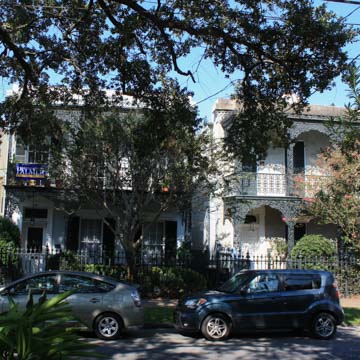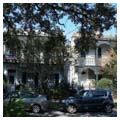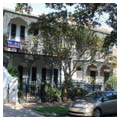These two houses were built by free woman of color Lucy Cheatam on land bequeathed by white cotton factor John Hagan to their two sons. In many ways a typical example of Esplanade Avenue’s two-story, side-hall houses, these are smaller and have a more human scale than many others on this street. They also differ in being set back behind front gardens. Constructed of brick, plastered and scored, the houses have facades shaded by two-story cast-iron galleries, one ornamented with a pattern of grapes and the other of flowers; number 529 has anthemion cresting. Entrance doors are surrounded by Greek key architraves, and the square-headed windows are finished with molded lintels. The building contract specified marble mantels and wallpaper, the latter very modish at the time, for the parlors. Two-story brick service wings extend from the rear of the houses.
You are here
Lucy Cheatam Houses
If SAH Archipedia has been useful to you, please consider supporting it.
SAH Archipedia tells the story of the United States through its buildings, landscapes, and cities. This freely available resource empowers the public with authoritative knowledge that deepens their understanding and appreciation of the built environment. But the Society of Architectural Historians, which created SAH Archipedia with University of Virginia Press, needs your support to maintain the high-caliber research, writing, photography, cartography, editing, design, and programming that make SAH Archipedia a trusted online resource available to all who value the history of place, heritage tourism, and learning.


















